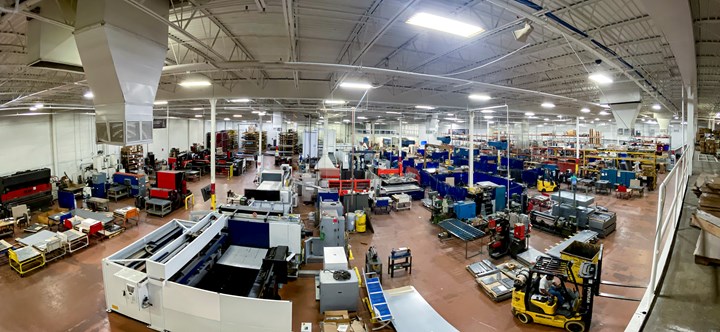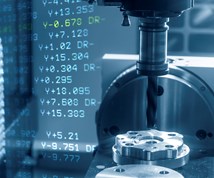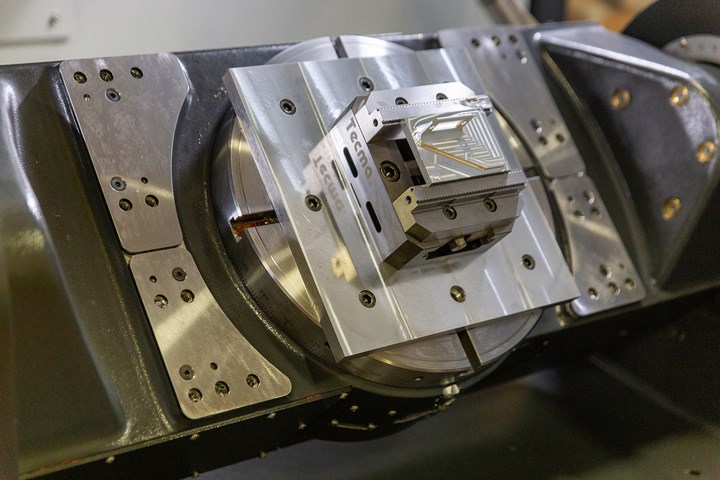Shops can gather all the machine data they want, but they won’t start to see any benefits until they figure out how to use that data. For All Metals Fabricating (AMF), giving employees visibility into their efficiency helped them improve their performance, but getting to the next level of productivity required a deeper dive.
All Metals Fabricating is an Allen, Texas-based contract manufacturer that performs sheet metal fabricating, powder coating, electromechanical assembly and machining for the telecom, banking/cash processing, medical, aerospace/defense and alternative energy industries.
Photo Credit: All Metals Fabricating
AMF is a contract manufacturer in Allen, Texas that works with the telecom, banking/cash processing, medical, aerospace/defense and alternative energy sectors. The company was founded in 1953, and current CEO Lance Thrailkill’s grandfather acquired it in 1978. Thrailkill took over in 2008, when his grandfather retired. The majority of AMF’s business (90%) is in sheet metal fabrication, powder coating and electromechanical assembly, while the remaining 10% comes from its machine shop, which includes three lathes, one horizontal mill, one five-axis machine and four three-axis machines. The company set up the machine shop in the 1990s, when it needed machined parts for some of its assemblies. Instead of sending it out, AMF brought the work in house. “That department has grown almost into its own entity,” Thrailkill says. “Now we do machine shop work that just comes through the machine shop and doesn’t go to any other department. We also still do a lot of machined components for assemblies.”
Featured Content
In 2020, AMF was transitioning to an all-digital scheduling system. Gaining more insight into the company’s performance was top of mind for Thrailkill when he learned about Alora, the machine monitoring program offered by ECI, the makers of the company’s ERP system, JobBoss. “I want to be able to run my shop from anywhere in the world on my cell phone, so my goal is to be able to have complete visibility into the company from my phone,” he says. “This was a step towards that.” Machine monitoring is also an important step on the company’s mission to become the most automated job shop in the world within the next 10 years. Thrailkill decided the time was right for AMF to start using machine monitoring, and the company began implementing Alora is early to mid-2021.
AMF was founded in 1953, but it didn’t add machining capabilities until the 1990s, when it started machining parts for some of its assemblies. Since then, the department has grown to account for 10% of the company’s business and includes three lathes, one horizontal mill, one five-axis machine and four three-axis machines. Photo Credit: All Metals Fabricating
Alora is now connected to half of AMF’s 50 machines. The system is also integrated with the company’s ERP program, JobBoss. “I would never, ever implement any software that is not integrated with our ERP system,” Thrailkill says. “That’s rule number one for me.” While this integration can add a bit of complexity to the implementation, he says that the benefits are significant. “It gives you even further visibility,” he says. “I can see what job operators are clocked in on, the machine that they’re running and what their utilization is on that machine for that job,” he says.
After the Alora team set up the system, they let it run for a month to collect data and establish a baseline. Many shops that implement machine monitoring are surprised by the initial machine utilization data, and AMF was no exception. “I was shocked,” Thrailkill says. Utilization on the company’s laser cutters was at 30-40%, much lower than expected. “We were thinking we needed to buy a new laser because we couldn’t keep up, but really, we weren’t even utilizing the lasers that we had to their capability,” he says. “Instead of us buying a million dollar machine, we ended up just getting more out of the equipment that we have.”
Up and Downtime
With a baseline established, the company set up a weekly, auto-generated report showing week-over-week utilization. The department leads use this report to drive weekly huddle meetings, discussing what worked and didn’t work, as well as improvement strategies. These meetings also give operators a chance to provide feedback on tools they need to improve their utilization rates. Thrailkill says operator feedback quickly resulted in small, simple changes that led to real results.
“We added an extra tooling cart for the machine shop,” he says. “They standardized some of the tooling setups, as well, in the machines to help reduce setup time.” Operators have also suggested bigger-picture changes, such as moving spot welding responsibilities from the press brake operators to the welders to make better use of the shop’s equipment.
Operators now use iPads to access Alora’s Downtime app and data about machine downtime. Additionally, they can view the utilization rates of the machines they’re running, as well as utilization rates for all machines in their department. They can also see what’s called the Machine Timeline, which shows utilization rates over the course of the day. AMF has even developed some of its own tools, including an employee performance dashboard. This dashboard shows time and attendance, efficiency ratings for every job, and any rejects that the employee was involved in.
“I took the concept of machine utilization and applied it to employee utilization,” Thrailkill explains. The company calculates how much time employees spend working on each job compared with how much time they spend clocked in at work. Any time an employee is clocked in but not running a job is overhead. This data provides more visibility for operators and incentivizes personal efficiency improvements. AMF uses this data to give bonuses to employees who complete jobs faster than the allotted time, as long as they are clocked in on jobs for 95% of the time they spend at work.
Hoping to gain more visibility through remote monitoring, AMF implemented Alora, a machine monitoring system from ECI, in 2021. It’s now connected to about 25 machines, and is integrated with the company’s JobBoss ERP program. Photo Credit: All Metals Fabricating
Dots and Dashes
These utilization dashboards are just the tip of the iceberg when it comes to data visualization. “Alora can build a dashboard out of just about anything, so we've got a bunch of different dashboards,” Thrailkill says. One is a capacity load dashboard, which shows the company’s available capacity. The leadership team discusses this data in weekly meetings, and account managers use it to determine how aggressive they can be in quoting lead times to customers. AMF also uses dashboards for its account managers to track sales performance and how much each account manager quotes every week.
One new dashboard that’s been particularly useful for AMF is the lights out dashboard. Where the employee dashboards only track utilization while employees are in the building, the lights out dashboard tracks utilization during unattended operation. The company has several machines that can run unattended, including a laser with a double-tower system, a punch press and a laser/punch combo machine with a pallet system, a robotic bending cell, and a lathe with a bar feeder and parts catcher. Before Alora, AMF didn’t have a good way to track its machines’ performance during lights out operation beyond using a camera system to review major problems.
“That was really big for us, because our main focus over the past six months was running lights out,” Thrailkill explains. “By having the machine monitoring, we can come in the morning, open up our dashboard and see how late it ran and track all that.”
Carrots and Sticks
Alora enabled AMF to calculate overall equipment effectiveness (OEE) for the first time. Previously it had been tracking operator efficiency, which showed if the company was making money or not, but it didn’t give visibility on whether its machines were being used to their fullest capacity. “When you pair the two, the efficiency of the operator and how well he’s utilizing his equipment, then you really get a full picture of the performance,” Thrailkill says.
But the results go beyond efficiency. Because Alora gives operators the ability to see their performance and aim to improve it, the software helps them improve their job satisfaction. “If you're doing the same thing all day, every day, it's monotonous work. You can lose purpose in that,” Thrailkill notes. “But when you are able to track how you’re doing and continually improve, it gives you more confidence and more fulfillment.”
Like many shop leaders who are considering machine monitoring, Thrailkill was concerned about the potential “Big Brother” element. But, after two years with Alora, he says that his fears have not come to fruition. A lot of it has to do with AMF’s approach to machine monitoring, he theorizes. “If you're going to use it as a way to help [your employees] see their performance and improve on their performance, then that's going to do the opposite,” he explains. “It's going to be a morale booster.” It’s a basic carrot versus stick situation: Instead of punishing employees with low utilization, AMF asks them what tools they need to improve, and rewards employees with high utilization by giving bonuses to operators with efficiency ratings over 100%.
Thrailkill says the bonus system has proved popular among employees, but AMF went through some trial and error to figure out a system that worked. First, the company tried rewarding the employees with the highest utilization with bonuses, but this created competition instead of teamwork. The company also realized it can’t compare different departments.
“It wasn’t really fair to have the machine shop, where operators are running two machines at once, to be competing against somebody doing assembly that can't gain that efficiency,” Thrailkill explains. The company is now working on a system that, instead of giving all employees with over 100% efficiency a set bonus, will reward employees based on how much additional money the employee made the company by completing jobs faster than estimated. “The more money you make the company,” he says, “the more money you get back into your pocket.”
Over the two years that Alora has been in place, utilization rates have increased by 152%. It has also enabled AMF to implement new programs that reward employees based on how much additional money the employee made the company, increasing job satisfaction.
Photo Credit: All Metals Fabricating
Ebbs and Flows
AMF was able to see results quickly after implementing Alora. “Now that they could track and see, our utilization rates jumped like 60% in the first three months,” Thrailkill says. In the two years since, the company’s utilization rates have increased by 152%, not including lights out operation. That equates to $240,000 in additional throughput throughout the year during attended operation, and he estimates that lights out operation adds another $240,000.
However, progress isn’t always steady. “Once you’ve had it for a little while, it’s a little bit trickier,” Thrailkill notes. “Because then the ebbs and flows of the business come into it.” If the company doesn’t have as much work for certain departments, or if someone has a challenging job, then utilization will go down. Eventually, as rates level off, the shop has to stay on top of the data and find new ways to keep improving. According to Thrailkill, to get to the next level, it’s management’s responsibility to look through the data to find trends and ask questions. “You can’t just rely on the operator to give you all that information, because they’re busy doing their job every day, trying to get the job done,” he says.
That’s why Thrailkill plans to spend the next year focusing on machine downtime. In addition to making sure that employees are consistently using the Downtime app and choosing the most accurate codes to give AMF a consistent stream of accurate data moving forward, the company has two years of data built up that it can dive into. It can see which machines are breaking down, why they’re breaking down and what preventative maintenance is in place, then use this information to look for additional opportunities for preventative maintenance. He’s also considering how to roll out Alora to other departments, such as welding and hardware installation, so they can also experience the benefits of machine monitoring.
RELATED CONTENT
-
CNC Machine Shop Honored for Automation, Machine Monitoring
From cobots to machine monitoring, this Top Shop honoree shows that machining technology is about more than the machine tool.
-
The CNC Reveals its Secrets
Machine monitoring becomes a platform for predictive maintenance without requiring extra sensors.
-
Shop Quotes Smarter, Works Harder with Machine Monitoring
Temco first installed MT-LINKi to optimize quoting. Now, the software helps the shop optimize its machines — and machine purchases.













.1692800306885.png)




.1687801407690.png)
